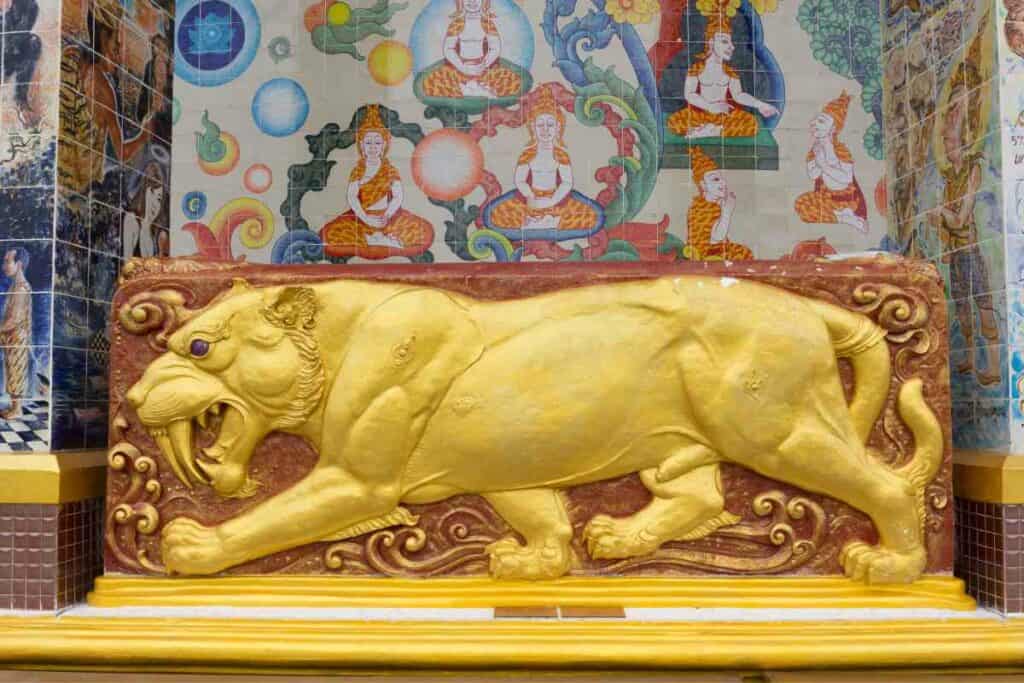Tigers are one of the world’s most recognizable and iconic big cats.
Known for their distinctive orange coat with black stripes, they are native to parts of Asia.
They are highly territorial and require large areas to hunt.

But you may be wondering, are there tigers in Japan?
Let’s look into it.
Table of Contents
Can You Spot a Tiger in Japan?
Sorry to disappoint the naturalists amongst you, but tigers are not native to Japan.
Tigers are, however, found in other parts of Asia, such as India, Southeast Asia, and parts of Siberia.
In Japan, native wildlife species include the:
- Japanese macaque
- sika deer
- Japanese serow
- and the Japanese giant salamander
There are a few species of wild cat native to Japan, however, but these are much smaller than the tiger.
They are the Tsushima Wildcat and the Iriomote Wildcat and are both endangered species, so you’d have difficulty spotting one – but we’ll let you know how later.
What about the cultural importance of Tigers in Japan?

Whilst you might not spot one in the wild in Japan, tigers hold a special cultural significance in the country across many different areas including folklore, art and martial arts.
Although tigers are not native to Japan, their cultural importance is represented in folklore, art, and symbolism. They will always hold a special place in Japanese culture as a symbol of power and protection.
The History of the Tiger in Japan
Tigers have a fascinating place in Japanese history.
Although never indigenous, their presence in Japanese history is mainly tied to cultural and artistic representations instead of actual sightings or natural habitats.

In ancient China, tigers held an important place in Chinese mythology. Over time, Japan adopted many aspects of Chinese culture, including Buddhism and Taoism. These early beliefs and stories brought the image of the tiger to Japan.
The most iconic representation of tigers in Japanese culture is the image of the tiger motif, which is used in traditional Japanese art and textiles.
Tiger imagery became popular in Japan during the Momoyama period in the late 16th century and the Edo period in the 17th to 18th century. The image of the tiger has been found on many kimonos, pottery pieces, and paintings from these eras.
Korean and Ryukyuan traditions also helped influence tiger imagery in Japan. As mentioned, tigers hold a special place in folklore and arts, and the legends and stories from these cultures helped to shape and hone tiger symbolism in Japan.
Although not native to Japan, tigers occasionally appeared in Japan’s zoos during the Edo period.
Tigers were brought to Japan as exotic imports from China or Korea and proudly showcased to the public. Their presence inspired curiosity and awe among Japanese people, helping the tiger’s mythical status.
In modern Japan, tigers continue to have a symbolic presence. Tiger imagery can be found in many aspects of Japanese culture, including tattoos, art, and traditional festivals.
The tiger’s influence on Japanese culture remains highly significant and enduring in Japan, even though tigers have never had a natural habitat there.
Tigers in Japanese Art

Again, whilst spotting a tiger in the wild in Japan is very much unlikely to happen (unless one’s broken out from a zoo!), you may well see plenty of them represented in artwork.
- Tiger Sculptures: Tiger sculptures can be found in various temples and shrines across Japan. The famous Todai-Ji temple in Nara has a massive wooden sculpture of a fierce-looking tiger. It is known as the “Tiger of Unkei.”
- Tiger Paintings: Tigers are frequently portrayed in traditional Japanese ink paintings, known as sumi-e or suibokuga. Some Japanese artists known for their tiger paintings are Maruyama Okyo and Kishi Ganku.
- Tiger Symbolism in Kabuki Theatre: Tigers are often represented in traditional Japanese Kabuki theater. The actors may wear tiger-themed costumes or incorporate tiger motifs into their makeup to portray intimidating characters.
- Contemporary Art: Tigers continue to inspire contemporary Japanese artists. Many modern Japanese artists incorporate tiger imagery into their works. This combines traditional and contemporary styles, from paintings to sculptures to digital art installations; tigers remain a popular subject for artistic expression.
Where Can I See Tigers in Japan?
Okay, so we know how important they are to Japanese culture, but you just want to know where you can see one in the flesh, right?

Despite not being a native species, you can see tigers at select zoos and wildlife parks in Japan.
One of the most popular places to see tigers is Tokyo Zoological Park, also known as Ueno Zoo, located in Tokyo.
They have a dedicated Tiger Forest exhibit where tigers can be observed up close.
Zoos play an essential role in conservation efforts, particularly with endangered species like tigers. They provide a controlled environment where tigers can be bred, cared for, and studied with the aim of understanding their biology and behaviors better. These efforts help contribute to conservation initiatives aimed at protecting tigers.
At Higashiyama Zoo and Botanical Gardens in Nagoya, they also have a tiger exhibit featuring Bengal tigers. The Hugashiyama Zoo is a great way to learn about this magnificent species.
Many other zoos and wildlife parks across Japan are home to tigers, including the Kyoto City Zoo in Kyoto, Tennoji Zoo in Osaka, and Asahiyama Zoo in Hokkaido.
To ensure you have the most up-to-date information, it is recommended that you contact the zoos directly for information on opening times and exhibits, etc.
It is always important to consider these incredible animals’ well-being and conservation efforts when searching for opportunities to view tigers in Japan.
You may also like ?
Wild Cats in Japan
Since tiger spotting is not really possible, spotting other wild cats might just hit the spot.
The leopard cat, which is also known as the Asian leopard cat, is a small wild cat species native to various parts of Asia, including parts of Japan.

It can be confused with the similar-looking domestic Bengal cat, but this is a crossbreed between the leopard and the domestic cat.
As mentioned earlier, this leopard cat is known as “iromote yayneko” or “tsushima yamaneko”, depending on the region.
The leopard cat is considered to be a critically endangered species; its population is estimated to be only around 100 animals. Leopard cats are usually found in forests and mangroves. Efforts are being made to protect their habitat and stop a further decline in their population.
The leopard cat is listed as a national monument of Japan and is endangered. The Tsushima yamaneko cat, of Tsushima Island is known for its distinctive appearance. It has shorter legs compared to other leopard cats.
Wild cats in Japan face many threats from road accidents, habitat loss, and interactions with humans, who may wish to hunt them. The Japanese government is trying hard to protect the wild cats and raise awareness of their conservation status.
Domestic cats, which are descended from wild cats, are found throughout Japan as pets and feral. Domestic cats are not considered native wildlife.
Read Next ?
Final Thoughts on Are There Tigers in Japan?
Although tigers are not native to Japan, there are many zoos where people can view them.
Many people in Japan love to see tigers up close given their rich cultural history in the country and the fact that they are celebrated as fierce warriors, depicting protection and bravery.
Traveling around Japan, you will see many temples and artworks adorned with the image of this magnificent creature, but sadly not one in the wild!
- Best Japanese Knives Top Picks for Every Kitchen
- Japan’s Bold New Trend: Dressing Like a British Gentleman (or at Least Trying)
- 7 Best Japanese Sunscreen Products You Can Buy Online
- 5 Best Japanese Makeup Brushes for a Flawless Finish
- 7 Benefits Of Tatami Mats You Should Know
- The Best Furoshiki Wrapping Cloths: Inspiration, Ideas & Cloths You Can Buy









